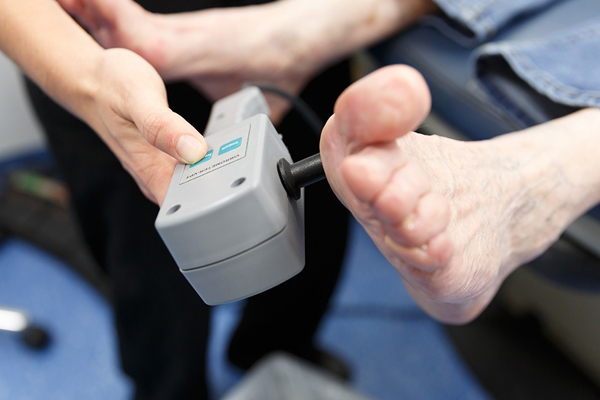Biothesiometer, Podiatry

Biothesiometer, Podiatry
What is a Biothesiometer?
A biothesiometer is a medical device used to assess vibratory sensation, primarily in the feet and hands. It is commonly used in podiatry and endocrinology clinics to evaluate patients for peripheral neuropathy, particularly in those with diabetes. The device measures a patient’s ability to perceive vibration, which helps detect early signs of nerve damage, a common complication in diabetic patients.
How Does a Biothesiometer Work?
The biothesiometer generates a controlled vibration through a small probe. This probe is placed on specific areas of the body, typically the big toe or the ball of the foot, to assess the patient’s ability to sense vibration. The device allows the healthcare provider to gradually increase the intensity of the vibration until the patient feels it.
- Sensor Application: The probe is applied to a specific area, usually on the foot or hand, where the patient may experience neuropathy symptoms.
- Vibration Intensity: The intensity of the vibration is increased gradually.
- Patient Response: The patient is asked to indicate when they first feel the vibration. This threshold is recorded.
- Data Interpretation: Higher thresholds (i.e., when patients only perceive strong vibrations) may indicate diminished nerve function, suggesting the presence of neuropathy.
Importance in Diabetic Neuropathy
Peripheral neuropathy is a common complication of diabetes, often affecting the feet and legs. Early detection is crucial for preventing more severe complications like foot ulcers and amputations. The biothesiometer helps detect early signs of neuropathy by measuring a decrease in vibratory sensation, which is often one of the first indicators of nerve damage.
- Early Detection: The biothesiometer allows for early identification of neuropathy, enabling timely intervention.
- Preventive Care: Regular screening with a biothesiometer can prevent more severe complications, such as foot ulcers or infections.
- Monitoring Progression: It helps track the progression of neuropathy over time, allowing for adjustments in treatment.
Podiatry: Foot Care for Diabetics and Beyond
What is Podiatry?
Podiatry is a branch of medicine that focuses on diagnosing, treating, and preventing conditions affecting the feet, ankles, and lower limbs. Podiatrists play a crucial role in managing foot health, particularly for patients with chronic conditions like diabetes, where foot care is essential to prevent complications.
Importance of Podiatry in Diabetes Management
For diabetic patients, foot care is an integral part of overall health management. High blood sugar levels can lead to nerve damage (neuropathy) and poor circulation, increasing the risk of foot problems such as infections, ulcers, and even amputations.
- Foot Exams: Regular podiatry visits allow for thorough foot examinations, helping to identify early signs of complications such as skin breakdown, infections, or deformities.
- Wound Care: Podiatrists specialize in treating diabetic foot ulcers and other foot wounds. Early intervention and proper care can prevent infections from worsening.
- Custom Orthotics: For patients with structural issues like flat feet, bunions, or hammertoes, podiatrists can provide custom orthotics to improve foot function and prevent pressure sores.
- Callus and Corn Removal: Diabetic patients often develop calluses or corns due to changes in foot structure. Podiatrists safely remove these, reducing the risk of ulceration.
Podiatric Treatments
- Debridement: Removing dead or damaged tissue from wounds to promote healing.
- Pressure Offloading: Using special footwear or devices to redistribute pressure on the feet, preventing ulcers or calluses from forming.
- Surgical Interventions: In cases where severe foot deformities or infections occur, podiatric surgery may be necessary to prevent further complications.
Preventive Foot Care Tips for Diabetics
- Daily Foot Inspection: Check feet for cuts, blisters, redness, or swelling.
- Keep Feet Clean and Dry: Wash and dry feet thoroughly every day, especially between the toes.
- Proper Footwear: Wear comfortable, well-fitting shoes that do not cause friction or pressure.
- Moisturize: Use lotion to keep the skin soft but avoid applying it between the toes.